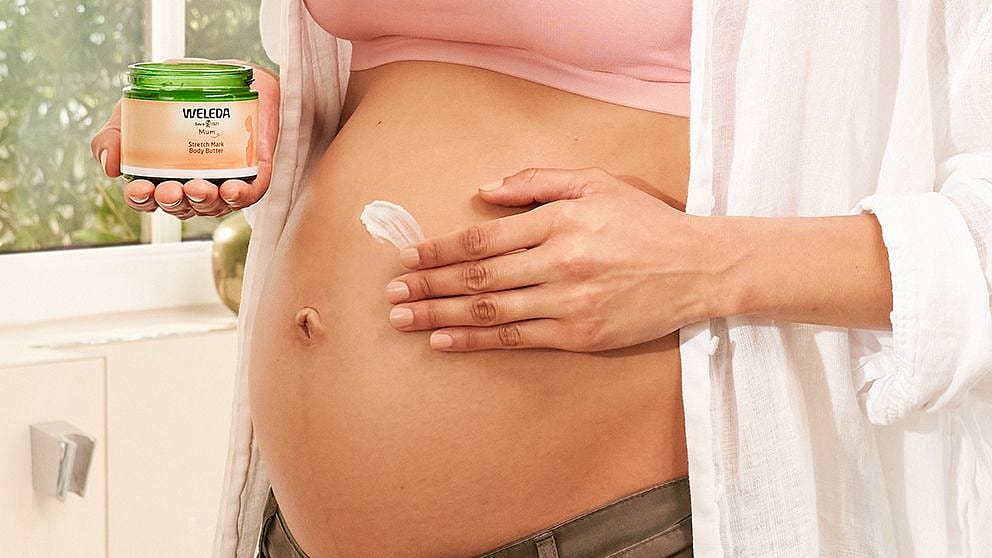Stretch mark prevention and care
Skin changes during pregnancy
During pregnancy, a mother’s body undergoes major changes. As the uterus expands to make room for the baby, the skin tissue can tear, causing stretch marks. What can be done to prevent pregnancy stretch marks?
How your skin changes during pregnancy
During pregnancy, the appearance of your skin also changes. The considerable increase in oestrogen levels affects the various aspects of your skin’s physiology, such as its thickness, capillary blood flow, collagen production and water content. During pregnancy, the skin stretches much faster and much more than it is used to. It becomes thinner and often appears dry and scaly, which causes itching in about 18 percent of pregnant women.
The epidermis (uppermost skin layer) of the belly stretches more intensively as the baby grows and maternal fat stores increase. While increased levels of oestrogen and other hormones during pregnancy help prepare the skin by increasing skin elasticity, they cannot do so indefinitely.
How do stretch marks form?
The balance between elastin and collagen fibres in the connective tissue can usually maintain the stability of the skin. If the stretching is constant and gradual, the collagen in the skin has time to regenerate. But pregnancy is an exceptional state, in which the skin in the abdomen area stretches much more quickly and intensively than usual. If the skin is pulled tight too quickly, an imbalance occurs in the connective tissue. This causes the elastic fibres of the subcutaneous layer to tear, resulting in a type of scarring, referred to as stretch marks. Additionally, hormonal changes during pregnancy make it harder for torn collagen fibres to recover, which increases the likelihood of stretch marks developing.
5 facts about stretch marks
Stretch marks (Latin: Striae gravidarum) generally do not pose a health problem. Nevertheless, this visible symptom of pregnancy bothers some women and can affect their self-esteem . Discover a few stretch mark facts below:
• Stretch marks usually appear during and after pregnancy on the abdomen, buttocks, breasts, thighs and arms.
• Around 50 to 90 percent of pregnant women get stretch marks.
• They typically occur in the late second and third trimesters.
• During pregnancy, they look like flat, pink to reddish-purple stripes (striae rubra).
• After breastfeeding, the streaks usually fade to lighter lines over several months or years. They can shrink and often become hypopigmented (striae alba). They typically do not disappear completely.
Common causes of stretch marks
The exact cause of stretch marks is unknown. Most stretch marks result from a mix of genetic and hormonal factors along with extreme mechanical stress on the connective tissue. Striae do not occur spontaneously but occur when the skin’s elastic fibres are pulled too tight.
Factors that increase the likelihood of developing stretch marks:
• Presence of stretch marks on different areas of the body, such as the abdomen, buttocks, thighs or breasts before your first pregnancy
• Tendency to develop striae in your family history
• Younger age of the mother
• A baby that is larger than average in the womb (increased birth weight, length, and head circumference).
• Women with a higher body mass index (BMI)
• Excessive weight gain during pregnancy (more than 21 kilograms).
Regardless of gender and age, stretch marks commonly occur as a result of rapid weight gain (obesity), muscle hypertrophy (bodybuilders), endocrinopathies (such as Cushing’s syndrome), breast enlargement, or as a side effect of medicines containing steroids.
Think of stretch marks as a reminder of what great things your body has done.
Tips for the prevention and care of stretch marks
Skin care during pregnancy
Taking care of your skin is especially important during pregnancy. The stretching that occurs during this time places the skin under immense stress, making it thinner and drier. Intensive care of the skin on your “baby bump” with moisturizing lotion or oil can help.
Plus, regular massage can increase the skin's elasticity and promotes blood circulation, so it does not tear as quickly. This reduces the probability of stretch marks appearing, even if they cannot be avoided entirely. A belly massage should be performed regularly, at least once a day. It’s best to start with them as early as possible in pregnancy, even before your belly bump begins to show. Many women gain a bit of weight in the first three months of pregnancy, but the most significant weight gain occurs in the second and especially the third trimester.
Postnatal skin care
Abdominal massages should be continued until the end of breastfeeding or three months after the birth – even if there are no stretch marks. Stretched skin needs time to heal. Regular massage can also measurably improve the condition of skin that already has stretch marks. Existing stretch marks can be visually reduced and lightened by massage, but – like other scars – they cannot be “massaged away”.
Regular skin care and circulation-enhancing massages improve the skin’s barrier function and provide it with moisture. They also reduce dry skin and unpleasant symptoms of itching and tightness.








